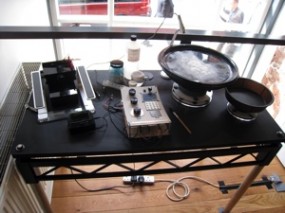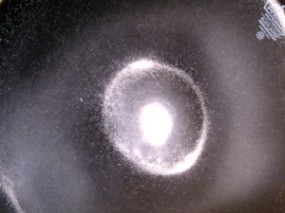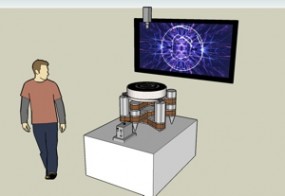BEAM ’12
Video documentation of my Symposium Pecha Kucha presentation and Open Space installation at BEAM 12, Brunel University, UK on 22nd – 24th June 2012.
Video documentation of Lewis Sykes’ presentation at the BEAM 2012 Symposium, Brunel University, 22nd June 2012.
iPhoto export of the slide show accompanying Lewis Sykes’ presentation at the BEAM 2012 Symposium, Brunel University, 22nd June 2012. This is the complete slide show and includes material not actually referred to in the presentation due to Lewis talking too much and running out of time…
Video documentation (not great sound quality) of a demonstration and explanation of my Augmented Tonoscope prototype to some unsuspecting visitor to BEAM 12.
I don’t usually feature the details of my submissions in this research journal – but it seemed appropriate here.
BEAM Open Space
There will be two dedicated rooms for the BEAM 2012 Open Space, open during the whole festival weekend. We welcome small installations (that don’t require sonic isolation or can use headphones) and demonstrations (something you’ve built or are experimenting with). Both are subject to sensible limitations e.g. size and danger – just think about what would work well in an open shared space. You’ll be asked to steward your specific station and to chat to interested viewers (breaks allowed!). The rooms will be stewarded more generally and technical support will be available to a limited number of BEAM Bursary artists.
Title (including artists’ name) and description (maximum 300 words):
The Augmented Tonoscope by Lewis Sykes
The Augmented Tonoscope is an artistic study into the aesthetics of sound and vibration through its analog in visual form – the modal wave patterns of Cymatics.
Dr Hans Jenny coined the term Cymatics (Greek: κῦμα “wave”) when he studied this subset of modal wave phenomena using a device of his own design – the ʻtonoscopeʼ.
Through my Practice as Research PhD project I’m designing, fabricating and crafting a contemporary version of Jenny’s sound visualisation tool – a sonically and visually responsive hybrid analogue/digital instrument that produces dynamic Visual Music – the Augmented Tonoscope. I then plan to play, record and interact with to produce a series of artistic works for live performance, screening and installation.
I’d like to share my work to date with the BEAM community and demonstrate my efforts to:
- explore a relationship between sound and image which is direct and elementary – analogs of each other in aural and visual form – and occurring in real-time;
- find an amalgam of image and sound that engages the viewer in a subtlety shifted way. A synchronisation between the senses of sight and hearing that results in a ‘co-sensing’ of a ‘co-expressiveness’ – where the mind is not doing two separate things, it’s doing the same thing in two ways. Akin to that by which Moritz (1976) critiques Oskar Fischinger’s synthetic sound production experiments: “Ah, but those visuals contain formulas and gestures that communicate with us subconsciously, directly, without being appreciated or evaluated.”;
- create a means and process whereby audio and visual composition occurs simultaneously – by merging the usually separate strands of audio and visual production into a single workflow to show that sounds and images can interact with, influence and shape each other from the outset and then throughout all stages of composition, arrangement and mixing.
(292 words)
Biography (maximum 200 words):
Lewis Sykes is a musician, interaction designer, digital media producer and curator and qualified Youth & Community Worker specialising in the Arts.
A veteran bass player of the underground dub-dance scene of the 90s he performed and recorded with acts such as Emperor Sly, Original Hi-Fi and Radical Dance Faction and was a partner in the underground dance label Zip Dog Records.
He refocused his interests in mixed media through an MA in Hypermedia Studies at the University of Westminster in 99-00 and continued to hone his fusion of music, visualisation and technology through a series of creative collaborations, such as musician with the progressive audiovisual collective The Sancho Plan (2005-2008) and currently as one-half of the sound and interaction project, Monomatic.
Lewis is Director of Cybersonica – an annual celebration of music, sound art and technology (now in its ninth year) – and between 2002-2007 was Coordinator of the independent digital arts agency Cybersalon – founding Artists-in-Residence at the Science Museum’s Dana Centre.
Lewis is in the second year of a practice as research PhD at MIRIAD, Manchester Metropolitan University exploring the aesthetics of sound and vibration.
Phd: www.augmentedtonoscope.net
Monomatic: http://www.monomatic.net
(189 words)
Link to video or audio (no physical files to be sent, links only):
http://vimeo.com/26541279 – A demonstration of The Augmented Tonoscope at State Of Play…, RIBA Hub, Manchester, UK, 4-11th July, 2011 – an exposition of ‘work in progress’ organised by the PPR Group as part of the PARC NorthWest Carnival.
Up to 3 marketing images (300dpi jpeg images only):
Brief tech spec, (maximum 200 words):
- a single 13 Amp power socket;
- a min 2500 lumen min XVGA resolution data projector would be useful for larger scale projection if desired.
My research is ongoing and documentation to date has been focussed on demonstrating proof of concept and showing prototypes in action. By June 2012, the version demonstrated in the ‘Link to video’ will be much more developed and the Visual Music outputs far more refined.
For BEAM 2012 the Augmented Tonoscope will be presented as an interactive, table top installation. A custom made, hands-on sine wave generator driving an analogue tonoscope with it’s visual output captured by a compact machine vision camera and displayed on a 22” touchscreen monitor. The monitor will also serve as a control interface for an integrated virtual tonoscope which is superimposed over and augments the analogue visualisation.
BEAM attendees will be able to explore the capabilities of this audiovisual instrument which will be configured in such a way as to make it immediate, accessible, playful, engaging and hopefully awe-inspiring too.
The touchscreen will also provide access to a navigable archive of project documentation and outputs – text, photographs and videos from key studio experiments, significant presentations and select performances.
NOTE: Due to it’s very nature the Augmented Tonoscope outputs low frequency sound and vibration which can’t be managed by headphones or directional speakers. It doesn’t require significant volumes to work but like any sound based work its audible. As a sonic artist I appreciate how annoying even low volume sound can be to others over the course of an exhibition so I’d suggest thinking about its location in relation to other works. An anti-vibration riser would certainly help.
(276 words… sorry)
BEAM Symposium
Held on Friday 22nd of June 2012 at Brunel University, 11am – 5pm. Join in!
This call is for the first BEAM (Brunel Electronic and Analogue Music) Symposium, to be held on Friday 22nd of June 2012 at Brunel University, prior to the BEAM 2012 Festival. We are now inviting proposals for Pecha Kucha Presentations and Papers that discuss interactivity or physicality in electronic music and may address the following areas (and example subsidiary questions):
- Sharing the latest discoveries in music creation: cutting-edge technology and its application to music / sound performance and installation
What are the most exciting potential developments in recent technology and what trends might they illuminate?
What innovations or discoveries have you yourself made?- Designing interfaces and the development of performance styles
Do new interfaces really enable more coherent performer / audience experiences?- Creating interactive or kinetic installations
What are the driving factors behind the artistic process and how has that moulded your discoveries?Proposals for the Pecha Kucha should take the form of an abstract of no more than 500 words. Papers should be no more than four A4 sides of Arial 12-point and will be presented in scheduled 15-minute slots, with 15 minutes for Q&A/discussion after each set of three papers. Papers will be peer-reviewed and both Papers and Presentations may be included in a published journal – we hope to confirm this shortly.
Institution (most recent, if no current institution):
Manchester Institute for Research & Innovation in Art & Design (MIRIAD), Manchester Metropolitan University, UK
Maximum 3 web links per proposal:
Phd Journal: http://www.augmentedtonoscope.net
PhD Digital Sketchbook: http://augmentedtonoscope.tumblr.com/
Monomatic: http://www.monomatic.net
Proposals for the Pecha Kucha should take the form of an abstract of no more than 500 words:
The Augmented Tonoscope – Abstract
I’m currently in the 2nd year of a Practice as Research PhD research project – The Augmented Tonoscope – at MIRIAD, MMU. My research question is:
“How far can artistic investigation into Cymatics – the study of wave phenomenon and vibration – contribute towards a deeper understanding of the interplay between sound and image in Visual Music?”
Through a Pecha Kucha presentation I’d like to share key aspects of my research to date – illustrating how gathering a body of complementary writing, documenting my process and artistic outputs and critically reflecting upon my progress has enabled me to break down my overall research question into component parts:
- What insights have I gleaned about Cymatics – the study of wave phenomenon and vibration?
- What constitutes artistic investigation into Cymatics?
- In what ways have I developed a deeper understanding of the interplay between sound and image?
- How can I contextualise this work within Visual Music and the wider arena of audiovisual culture?
- How will my methods – in particular building an instrument – enable me to realise this?
(168 words)




